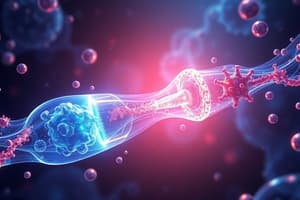Podcast
Questions and Answers
What is a consequence of drugs being bound to plasma proteins?
What is a consequence of drugs being bound to plasma proteins?
- They become more easily metabolized.
- They can cross biological membranes easily.
- They enhance the therapeutic effects immediately.
- They remain inactive and cannot be excreted. (correct)
Which of the following drugs is primarily stored in fat?
Which of the following drugs is primarily stored in fat?
- Tetracyclines
- Phenylbutazone
- Digitalis
- Thiopental (correct)
How does protein binding facilitate drug distribution?
How does protein binding facilitate drug distribution?
- By making drugs more accessible to metabolizing enzymes.
- By acting as a carrier for drugs insoluble in body fluids. (correct)
- By increasing the concentration of free drug molecules.
- By accelerating the excretion of the drugs.
In hypo-proteinemia, what adjustment should be made regarding drug dosing?
In hypo-proteinemia, what adjustment should be made regarding drug dosing?
What effect can occur when one protein-bound drug replaces another with a higher affinity?
What effect can occur when one protein-bound drug replaces another with a higher affinity?
What process moves molecules from low concentration to high concentration using energy?
What process moves molecules from low concentration to high concentration using energy?
Which factor does NOT influence the rate of drug absorption?
Which factor does NOT influence the rate of drug absorption?
How does facilitated diffusion differ from passive transport?
How does facilitated diffusion differ from passive transport?
Which of the following cell membrane components plays a role in passive transport?
Which of the following cell membrane components plays a role in passive transport?
What is a primary example of active transport as mentioned in the content?
What is a primary example of active transport as mentioned in the content?
What commonly helps non-lipid soluble drugs to penetrate the cell membrane?
What commonly helps non-lipid soluble drugs to penetrate the cell membrane?
Which of the following is NOT a characteristic of the cell plasma membrane?
Which of the following is NOT a characteristic of the cell plasma membrane?
Which statement about diffusion is accurate?
Which statement about diffusion is accurate?
Which factor does NOT affect drug absorption?
Which factor does NOT affect drug absorption?
What is the primary role of pinocytosis in drug transport?
What is the primary role of pinocytosis in drug transport?
Which of the following barriers is selectively permeable to certain drugs?
Which of the following barriers is selectively permeable to certain drugs?
Which type of drug formulation is absorbed most rapidly?
Which type of drug formulation is absorbed most rapidly?
What happens to a drug that is bounded to plasma proteins?
What happens to a drug that is bounded to plasma proteins?
Which of the following is NOT considered a physiological factor affecting drug distribution?
Which of the following is NOT considered a physiological factor affecting drug distribution?
In which circumstance would drugs be most likely to pass the blood placental barrier?
In which circumstance would drugs be most likely to pass the blood placental barrier?
What is the role of glial cells in the capillaries of certain organs?
What is the role of glial cells in the capillaries of certain organs?
Flashcards are hidden until you start studying
Study Notes
Drug Absorption
- Drugs move across biological membranes through diffusion from an area of high concentration to low concentration.
- The rate of diffusion is influenced by lipid solubility, size, degree of ionization, and the area of the absorptive surface.
Passage of Drug Across Cell Membranes
- Physiochemical factors influencing drug movement:
- Drug molecule characteristics:
- Molecular size and shape
- Lipid solubility
- Cell membrane:
- Composed of two layers of protein and a lipid center with pores.
- Drug molecule characteristics:
Processes of Crossing the Cell Membrane
-
Passive transport:
- Movement of molecules through specific transport proteins down a concentration gradient.
- Does not require energy.
- Example: Glucose uptake by liver cells via GLUT4 transporter.
-
Active transport:
- Movement of molecules against a concentration gradient.
- Requires energy supplied by ATP breakdown.
- Example: Sodium-potassium pump in nerve cells.
-
Facilitated diffusion:
- Molecules move from a higher concentration to a lower concentration with assistance from a carrier.
- Non-lipid soluble drugs can cross the lipid matrix using carrier enzymes.
-
Pinocytosis:
- Movement of large lipid-insoluble molecules through endocytosis.
- Cell membranes envelop the substances into vesicles for transport.
- Energy-consuming process.
Factors Affecting Absorption
-
Drug-related factors:
- Physiochemical properties:
- Lipid solubility
- Degree of ionization
- Molecular weight and valiancy
- Chemical nature (organic or inorganic)
- Pharmaceutical form:
- Solutions are absorbed faster than suspensions or powders (depending on particle size).
- Physiochemical properties:
-
Patient/animal-related factors:
- Pathological condition of the absorbing surface
- Rate of general circulation
- Specific factors
- Route of drug administration
Drug Distribution
- After absorption, drugs are distributed to various body compartments:
- Free in blood plasma
- Free in extracellular fluid
- Free in intracellular fluid
- Bound to plasma proteins
- Bound to tissue proteins
- Stored in fat depots
- Distribution in extra or intracellular fluid depends on the pH gradient of the two fluids.
- Some organs have barriers that restrict drug entry.
- Blood barriers:
- Glial cells in capillaries of specific organs selectively permit certain drugs to pass.
- Blood-brain barrier (BBB) restricts passage to the CNS and CSF.
- Quaternary ammonium compounds (e.g., neostigmine) cannot pass, while anesthetics can.
- Drugs acting on the CNS must be able to cross the BBB.
- Blood-placental barrier restricts passage to the fetus.
- May lead to resorption, abortion, malformation, or fetal depression.
- Drugs for pregnant patients should not cross this barrier.
- Other barriers include intestinal, serous, and milk barriers.
Storage Depots
-
Plasma proteins:
- Albumin and other plasma proteins can bind to drug molecules.
- Bound drugs are inactive, not metabolized or excreted.
- Example: Phenylbutazone.
-
Extracellular depots:
- Connective tissue binds to ionic mucopolysaccharides.
- Hair, bones, and teeth can store heavy metals and tetracyclines.
-
Tissue proteins:
- Some drugs bind to tissue proteins more than plasma proteins.
- Example: Digitalis in cardiac muscle.
-
Fat:
- Important storage site for lipid-soluble drugs.
- Example: Thiopental.
-
Redistribution of drugs from the site of action to other sites (e.g., thiopental from brain to fat) terminates their effect.
Protein Binding
-
Specific affinity:
- Varies for different drugs and across animal species.
- May influence drug absorption, distribution, biotransformation, and excretion rates.
-
Reversible process:
- Bound drugs are inactive.
- Bound drugs cannot cross biological membranes, be metabolized, or be excreted.
Effects of Protein Binding on Drug Kinetics
- Facilitation of absorption:
- Low concentration of free molecules.
- Facilitation of distribution:
- Carrier for drugs insoluble in plasma.
- Example: Steroids.
- Prolongation of drug action:
- Buffers drug concentration, slows metabolism or excretion.
- Increasing initial doses:
- To achieve therapeutic dose of unbound drug.
- Lowering the dose in hypoproteinemia:
- To avoid drug toxicity.
- Drug interactions:
- Drugs with higher affinity can displace other protein-bound drugs, leading to toxicity.
- Example: Phenylbutazone with dicoumarol or salicylates with thyroxine.
Studying That Suits You
Use AI to generate personalized quizzes and flashcards to suit your learning preferences.




